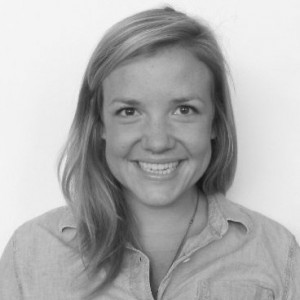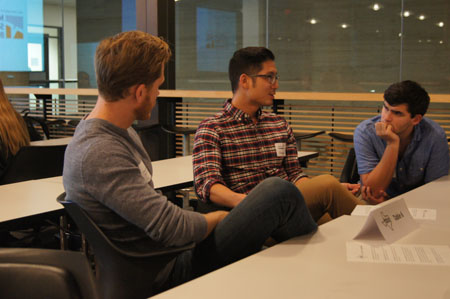 Haley Robison, BHP 2007, is CEO for KAMMOK, an Austin-based company providing quality outdoor gear and apparel to the socially-conscious adventurer. She has quite a diverse background from consulting with Bain & Co. to leading backpacking expeditions. Haley will be leading a Career Design session for BHP students in the fall to help them assess their priorities and apply design thinking towards career exploration.
Haley Robison, BHP 2007, is CEO for KAMMOK, an Austin-based company providing quality outdoor gear and apparel to the socially-conscious adventurer. She has quite a diverse background from consulting with Bain & Co. to leading backpacking expeditions. Haley will be leading a Career Design session for BHP students in the fall to help them assess their priorities and apply design thinking towards career exploration.
You have had quite an interesting path since graduating. Take us through your career path.
I joined Bain & Co. after graduation and worked there for a little more than three years. I took advantage of the externship program there and moved to San Francisco for six months to help Summer Search build a strategic partnership plan. I left Bain in 2010 to pursue my interest in outdoor education. I signed up for a wilderness course through the National Outdoor Leadership School (NOLS). Through that program, I lived outside from February to May in 2011 in Wyoming and Utah.
After that, I decided to pursue a year-long theology program, the Trinity Forum Academy to explore the big “why” questions. I was trying to figure out who I was and find my calling. As part of my fellowship, I wrote a thesis exploring human experience in nature. During that time, I applied to the Stanford Graduate School and was accepted. Before starting at Stanford, I spent the summer working for a company called Solid Rock leading extended backpacking trips for high school girls. In the fall I went to Stanford and was there for two-and-a-half years completing joint master’s degrees in business and education. I worked at IDEO for the summer of 2013 as an organization designer. After graduation, I stayed on with Stanford in their Design School to design curriculum.
From there, I met an investor for KAMMOK, by chance, in Palo Alto and got connected to the founder of KAMMOK, which is where I am now. I have had this incredible opportunity to help them scale, and to combine all of my interests, passions, and skills in design and outdoors.
Did you have a path in mind for yourself or were you just open to opportunities as they came about?
I wasn’t sure what I wanted to do after graduating. Like many students in that situation, I thought consulting would be a great way to figure that out. I just kept saying yes and pursuing doors that opened and seemed interesting to me. I have had a non-linear path, but looking back it is easy to connect the dots. It didn’t feel that way at the time though. I didn’t have a path in mind. I would have never thought I would run an outdoor apparel company when I was 30, but it now makes sense to me that I would have ended up where I am given what I care about and am interested in. I also never thought I would want to work for a product company, but KAMMOK has been an exciting opportunity. I am able to explore how product companies have an impact in the world and serve as catalysts for some of our most impactful experiences. It has been interesting exploring how to design and sell products around people and experiences.
Your LinkedIn profile title says “outdoor and design enthusiast.” Talk about your passion for both of these areas and how they are a part of your current role.
I have had some pretty transformative experiences in the outdoors, both individually and with other people as part of a community. Experiences in the outdoors can really shape our character, our understanding of who we are as individuals, and our understanding of the world around us. I really love designing experiences through the lens of people and learning objectives. I enjoy figuring out what the experience is that would unlock insights and learning for people.
In our industry there is a huge trend towards urbanization. Outdoor brands are having to ask a lot of interesting questions around how we encourage people to experience the outdoors from where they are. The products we create need to be able to transition with you from the backyard to the back country, and need to have utility in a city and beyond. As we think about expanding our mission to get people outdoors and expanding our products, the first questions we ask are who we are designing for, what do they need, and what does their life look like. Through that lens, I get to be a designer every day.
You participated in and also led intense outdoor expeditions. What can be learned in those programs?
I saw incredible life change in the high school girls I led on backpacking expeditions. If you string up a hammock in your backyard and look up, you have a different perspective. This perspective change can ground us. We live in a hyper-connected world and there is something about disconnecting and reconnecting with a sense of just being and feeling all the elements that is very refreshing. It is also challenging at times. You have to think practically and creatively to deal with outdoor challenges. Learning how to do that is applicable in everyday life. You also learn you have more in you than you realize when you are challenged by things that are unknown or intimidate you. A lot of times in the outdoors we face those challenges, whether physically, spiritually or emotionally, and conquering those can boost your confidence. I also think conservation and recreation are tied. We are realizing the impact we have on our environment and we need to be good stewards of our environment. To care for something, you have to love it and know it, so spending time outdoors can help us cultivate a sense of responsibility and stewardship for our environment.
How did the Career Design project at Stanford come about for you?
I spent a lot of time at the Design School at Stanford developing curriculum. They were looking to hire a curriculum designer to redesign their career offerings for incoming MBA students. I jumped at the opportunity and I got to help shape what that looked like. We built a series of six workshops based on student input. The goal was to equip students with a toolkit for exploring careers effectively and to teach them how keep a strong sense of self during their time in the program, so they didn’t fall into herd mentality. We also equipped them with the tools for taking action, so they could try out areas of interest and make progress towards their goals.
What are KAMMOK’s growth goals right now and what are you focused on as the new CEO.
We more than doubled revenue in 2015, rolled out nationally to all REI stores, and increased our online business significantly. Our growth goals are to continue to grow a profitable omni-channel business, to continue to deepen our core accounts, and to build a robust offering on KAMMOK.com. Our mission is to equip and inspire life-changing adventure. We want to continue to build our brand story and invite people into a lifestyle of adventure. Right now we are a product company, but we want to add experiences. Our focus for now though is to figure out what the best products are to amplify our mission. We are defining technical outdoor for the urban millennial and thinking about the best products. We also want to create a fantastic digital experience for our customers on KAMMOK.com. Financially we are hoping to have double-digit revenue growth again this year. A big thing on the horizon is that we are moving into a new space in the heart of East Austin. This will be our first retail presence, and will help us become more relevant in Austin. We hope the store will be a great resource for people who want to get outdoors and have questions about what gear to use.
What do you most enjoy about working for KAMMOK?
I love that our team owns KAMMOK. In this business if you fail, you get real-time feedback on that. That sense of ownership is incredibly powerful and I haven’t had that in more service-related jobs. I also love the mission of KAMMOK. We see products as a catalyst for life change and we want to create products that lead to magical experiences for people. I enjoy building our team to amplify that mission.
What advice do you have for current BHP students?
I would tell them everything is going to be okay. There can be a lot of pressure to figure it out and I don’t know that we ever figure it out. Figuring it out is the journey and is a beautiful process. Have confidence in what a next step looks like and don’t feel pressure to get it right. The millennial generation will change jobs potentially 20 times in their lifetime. Don’t be afraid to take a risk. There are certain tracks people file into. If you already know that isn’t you, create an opportunity for yourself and don’t just respond to opportunities in front of you.


